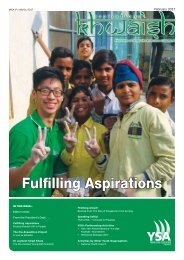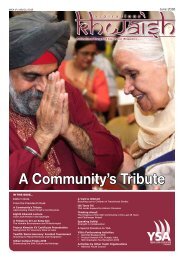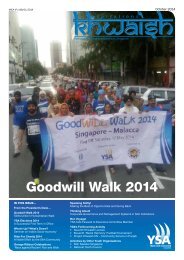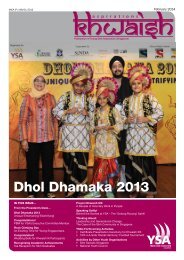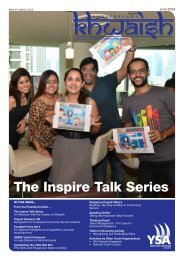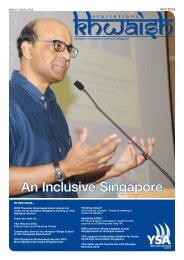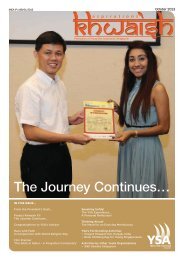ISS-Magazine_v7
You also want an ePaper? Increase the reach of your titles
YUMPU automatically turns print PDFs into web optimized ePapers that Google loves.
Over time, an increasing number of Sikhs made the decision to settle in Singapore. This resulted in the arrival of their<br />
spouses in Singapore. Hailing from India, these women found themselves in a foreign country where they could not<br />
speak the language and had few or no friends and acquaintances. Their boundary was primarily their homes where they<br />
spent time tending to household chores. Many of the male folks took on more than one job, thus being away from home<br />
for much of the day and even night. As such, the women had little or no social interaction with the rest of the community.<br />
After the Second World War, a group of concerned Sikh women came together to form Istri<br />
Sat Sang Singapore (<strong>ISS</strong>). They wanted to create a platform to bring Sikh women together so<br />
that they could meet and interact with one another. At the same time, they could participate in<br />
religious, social and cultural activities. Oral history reveals that <strong>ISS</strong> was established at CST on 26<br />
March 1946. It is believed that Mdm Rattan Kaur (mother of Dr Bhagwant Singh, now residing in<br />
Adelaide, Australia) was its first president.<br />
<strong>ISS</strong> was the only known Sikh-women platform at that time. It naturally became an important<br />
Mdm Rattan Kaur<br />
channel for Sikh women to meet, interact and participate in religious and social activities. Like<br />
Sikh men using the gurdwaras as meeting points to discuss Punjab affairs, among others, Sikh<br />
women also saw <strong>ISS</strong> as an important platform to meet other Sikh women and to exchange news and developments in<br />
their homeland.<br />
Formalisation and Inauguration<br />
Since its establishment, <strong>ISS</strong> functioned as an informal organisation. On 17 July 1963, its members held a meeting and<br />
decided to elect an Executive Council. Eleven Executive Council members were elected. This marked the formalisation<br />
of <strong>ISS</strong>, some 17 years after its establishment.<br />
The members then drew up the constitution and <strong>ISS</strong> was formally registered as a society on 2 March 1964. The key<br />
appointment holders were:<br />
Mdm Dyal Kaur<br />
President<br />
Mdm Gurcharan Kaur<br />
Vice President<br />
Mdm Kartar Kaur<br />
Secretary<br />
Mdm Surjit Kaur<br />
Treasurer<br />
Its key objectives were:<br />
• To provide religious and educational advancement.<br />
• To provide social and religious activities.<br />
• To hold prayer meetings and organise religious programmes, for example, Sukhmani Sahib (Treasure of Peace).<br />
• To participate and selflessly contribute to gurpurabs (celebration of an anniversary related to the Sikh Gurus’ lives)<br />
at CST.<br />
• To contribute to fundraising efforts in supporting building renovation initiatives not only at CST and Sikh institutions in<br />
Singapore but also at other gurdwaras across the Causeway.<br />
Following its formalisation, <strong>ISS</strong> became more organised, with regular meetings and election of Executive Council<br />
members, as well as the organisation of a regular slate of programmes and activities.<br />
Mission, Vision and Activities<br />
In an effort to provide meaning and direction, <strong>ISS</strong> developed the vision of propagating Sikhism and being an active player<br />
in providing support to initiatives at CST and the Central Sikh Coordinating Council.<br />
10







